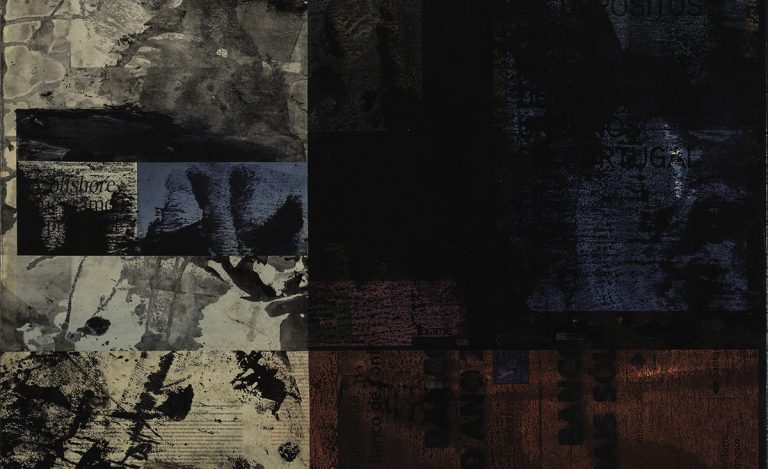José Brito Santos doesn’t paint for the sake of beauty. He paints to grapple with the noise of the world. His art doesn’t sit quietly in the background; it stands right in front of you, daring you to look away. Based in Portugal, Brito uses thick black ink, glued newspaper clippings, and rough textures to tell stories that aren’t simple or clean. His canvases feel like living, breathing battlegrounds—crowded, loud, and deeply human.

His materials come with their own baggage: pages that once carried news, words that once held meaning, now stripped and reassembled. Brito’s paintings are not just images; they’re confrontations. They reflect a world that’s overwhelming, fragmented, and raw. Through every mark he makes, Brito reminds us that art isn’t just something you see—it’s something you wrestle with.
The Work: The Chaos and the Black Spots
In this series, José Brito Santos questions what communication has become.
Not just what is said, but how we receive it—and what it does to us.
He asks: when information is faster, wider, and louder than ever, does it still connect us? Or does it leave us spinning in a cycle of noise? Who’s even listening anymore? If communication is more than just the data, but also the way it’s shaped, then how does it change the way we feel, see, or even move through the world?
Brito doesn’t pick one clean side of communication to show. He prefers the chaos. He takes the front, the back, the parts no one sees. His paintings let the mess run wild. They don’t hand you one simple version of the truth—you can’t even see everything at once. It’s overwhelming because that’s the point.
He captures this messy show of modern communication like a collage of broken images and scattered words. Newspaper pages form the backbone of the paintings, slapped onto the canvas and stained with thick, heavy black ink. You see pieces of sentences, flashes of headlines—but never the full story. Then the black spots take over. They’re wild, raw, moving across the surface like shadows you can’t hold onto.
Each canvas feels like a broken thought, a memory half-formed. Brito pulls you into a space where opposites clash: light against dark, clarity against confusion.
Is there light without darkness?
Is there understanding without misunderstanding?
He doesn’t answer. He just shows you the battle.
The black marks are not delicate. They don’t aim for beauty. They represent something closer to instinct—wildness, freedom, the parts of us that can’t be polished or tamed. They rage across the surface, tearing through the polished mask that communication often wears.
And yet, Brito doesn’t drown everything in black. Tiny shards of color, slivers of words, and flashes of old meaning poke through. There’s tension in every painting—the black pressing down, the old fragments fighting to survive underneath.
As you move from one painting to the next, you start to see a pattern. Brito is building a new kind of memory. A memory that lets go. He accepts the fact that perfect communication isn’t just rare—it’s maybe impossible. He creates a new net out of this brokenness, a new way of feeling that doesn’t belong to the global noise machine.
In a world full of polished messages and brand-perfect images, Brito’s work feels raw and human. It invites you into the uncertainty instead of pretending it doesn’t exist.
It doesn’t give you answers.
It gives you the feeling of standing in the middle of it all—lost, furious, hopeful—and still reaching for something real.

